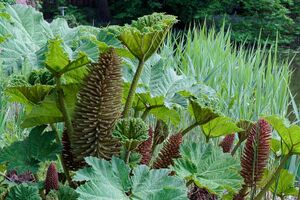Gunnera Cyanobacteria symbiosis: Difference between revisions
No edit summary |
No edit summary |
||
| Line 5: | Line 5: | ||
==<i>Cyanobacteria</i>== | ==<i>Cyanobacteria</i>== | ||
<i>Cyanobacteria</i> are the largest phylum of Gram-positive prokaryotes on earth dating back to 3.5 billion years ago<ref>[https://www.science.org/doi/abs/10.1126/science.11539686 Schopf, J. W., & Packer, B. M. (1987). Early Archean (3.3-billion to 3.5-billion-year-old) microfossils from Warrawoona Group, Australia. <i>Science, 237</i>(4810), 70-73. | <i>Cyanobacteria</i> are the largest phylum of Gram-positive prokaryotes on earth dating back to 3.5 billion years ago<ref>[https://www.science.org/doi/abs/10.1126/science.11539686 Schopf, J. W., & Packer, B. M. (1987). Early Archean (3.3-billion to 3.5-billion-year-old) microfossils from Warrawoona Group, Australia. <i>Science, 237</i>(4810), 70-73.]</ref>. They evolved the ability to use photosynthesis to obtain their energy, making them different from other single celled organisms at the time <ref>[https://www.sciencedirect.com/science/article/pii/S0168945207003202?via%3Dihub Sinha, R. P., & Häder, D. P. (2008). UV-protectants in cyanobacteria. <i>Plant Science</i>, 174(3), 278-289.]</ref>. By photosynthesizing, the <i>Cyanobacteria</i> produce oxygen as a byproduct. This is believed to have both helped the bacteria successfully prosper because the environment in which they were developing was otherwise occupied by anaerobic bacteria and caused the Great Oxidation Event <ref>[https://books.google.com/books?hl=en&lr=&id=4oJ_vi27s18C&oi=fnd&pg=PR3&dq=Whitton+BA,+ed.+(2012).+%22The+fossil+record+of+cyanobacteria%22.+Ecology+of+Cyanobacteria+II:+Their+Diversity+in+Space+and+Time.+Springer+Science+%26+Business+Media.+pp.+17%E2%80%93.+&ots=JG1mYJsMTT&sig=yuPO7pmok3mkSV5sDkrOn0uGc4U#v=onepage&q=Whitton%20BA%2C%20ed.%20(2012).%20%22The%20fossil%20record%20of%20cyanobacteria%22.%20Ecology%20of%20Cyanobacteria%20II%3A%20Their%20Diversity%20in%20Space%20and%20Time.%20Springer%20Science%20%26%20Business%20Media.%20pp.%2017%E2%80%93.&f=false Whitton, B. A. (Ed.). (2012). <i>Ecology of cyanobacteria II: their diversity in space and time</i>. Springer Science & Business Media.]</ref>. The Great Oxidation Event is where the earth first experiences a rise in the amount of oxygen in the atmosphere and oceans<ref>[https://www.science.org/doi/abs/10.1126/science.11539686 Lyons, T. W., Reinhard, C. T., & Planavsky, N. J. (2014). The rise of oxygen in Earth’s early ocean and atmosphere. <i>Nature, 506</i>(7488), 307-315.]</ref>. | ||
]</ref>. They evolved the ability to use photosynthesis to obtain their energy, making them different from other single celled organisms at the time <ref>[https://www.sciencedirect.com/science/article/pii/S0168945207003202?via%3Dihub Sinha, R. P., & Häder, D. P. (2008). UV-protectants in cyanobacteria. <i>Plant Science</i>, 174(3), 278-289.]</ref>. By photosynthesizing, the <i>Cyanobacteria</i> produce oxygen as a byproduct. This is believed to have both helped the bacteria successfully prosper because the environment in which they were developing was otherwise occupied by anaerobic bacteria and caused the Great Oxidation Event <ref>[https://books.google.com/books?hl=en&lr=&id=4oJ_vi27s18C&oi=fnd&pg=PR3&dq=Whitton+BA,+ed.+(2012).+%22The+fossil+record+of+cyanobacteria%22.+Ecology+of+Cyanobacteria+II:+Their+Diversity+in+Space+and+Time.+Springer+Science+%26+Business+Media.+pp.+17%E2%80%93.+&ots=JG1mYJsMTT&sig=yuPO7pmok3mkSV5sDkrOn0uGc4U#v=onepage&q=Whitton%20BA%2C%20ed.%20(2012).%20%22The%20fossil%20record%20of%20cyanobacteria%22.%20Ecology%20of%20Cyanobacteria%20II%3A%20Their%20Diversity%20in%20Space%20and%20Time.%20Springer%20Science%20%26%20Business%20Media.%20pp.%2017%E2%80%93.&f=false Whitton, B. A. (Ed.). (2012). <i>Ecology of cyanobacteria II: their diversity in space and time</i>. Springer Science & Business Media.]</ref>. The Great Oxidation Event is where the earth first experiences a rise in the amount of oxygen in the atmosphere and oceans<ref>[https://www.science.org/doi/abs/10.1126/science.11539686 Lyons, T. W., Reinhard, C. T., & Planavsky, N. J. (2014). The rise of oxygen in Earth’s early ocean and atmosphere. <i>Nature, 506</i>(7488), 307-315.]</ref>. | |||
Revision as of 02:59, 8 November 2021
Gunnera

Cyanobacteria
Cyanobacteria are the largest phylum of Gram-positive prokaryotes on earth dating back to 3.5 billion years ago[1]. They evolved the ability to use photosynthesis to obtain their energy, making them different from other single celled organisms at the time [2]. By photosynthesizing, the Cyanobacteria produce oxygen as a byproduct. This is believed to have both helped the bacteria successfully prosper because the environment in which they were developing was otherwise occupied by anaerobic bacteria and caused the Great Oxidation Event [3]. The Great Oxidation Event is where the earth first experiences a rise in the amount of oxygen in the atmosphere and oceans[4].
Many species live in large colonies of cells ranging from hundreds to thousands of cells in a single colony [5]. These colonies are able to form filaments, sheets, or hollow spheres [6]. When too large, they can form harmful algal blooms that can cause great harm to the aquatic ecosystem and the surrounding area it is in [7]. Cyanobacteria can be found in almost any terrestrial or aquatic environment ranging from oceans and lakes to extremes like wet rocks in a desert or in the Antarctic [8]
Cyanobacteria are wide spread around the world, contributing to major global biogeochemical cycles like cellular death [9].
Gunnera and Cyanobacteria symbiosis
Include some current research, with a second image.
Conclusion
Overall text length (all text sections) should be at least 1,000 words (before counting references), with at least 2 images.
Include at least 5 references under References section.
References
- ↑ Schopf, J. W., & Packer, B. M. (1987). Early Archean (3.3-billion to 3.5-billion-year-old) microfossils from Warrawoona Group, Australia. Science, 237(4810), 70-73.
- ↑ Sinha, R. P., & Häder, D. P. (2008). UV-protectants in cyanobacteria. Plant Science, 174(3), 278-289.
- ↑ Whitton, B. A. (Ed.). (2012). Ecology of cyanobacteria II: their diversity in space and time. Springer Science & Business Media.
- ↑ Lyons, T. W., Reinhard, C. T., & Planavsky, N. J. (2014). The rise of oxygen in Earth’s early ocean and atmosphere. Nature, 506(7488), 307-315.
- ↑ Tamulonis, C., Postma, M., & Kaandorp, J. (2011). Modeling filamentous cyanobacteria reveals the advantages of long and fast trichomes for optimizing light exposure. PLoS One, 6(7), e22084.
- ↑ Aguilera, A., Klemenčič, M., Sueldo, D. J., Rzymski, P., Giannuzzi, L., & Martin, M. V. (2021). Cell death in Cyanobacteria: current understanding and recommendations for a consensus on its nomenclature. Frontiers in Microbiology, 12, 416.
- ↑ Paerl, H. W., & Otten, T. G. (2013). Harmful cyanobacterial blooms: causes, consequences, and controls. Microbial ecology, 65(4), 995-1010.(Pearl and Otten)
- ↑ De Los Ríos, A., Grube, M., Sancho, L. G., & Ascaso, C. (2007). Ultrastructural and genetic characteristics of endolithic cyanobacterial biofilms colonizing Antarctic granite rocks. FEMS microbiology ecology, 59(2), 386-395.
- ↑ Aguilera, A., Klemenčič, M., Sueldo, D. J., Rzymski, P., Giannuzzi, L., & Martin, M. V. (2021). Cell death in Cyanobacteria: current understanding and recommendations for a consensus on its nomenclature. Frontiers in Microbiology, 12, 416.
Edited by Rachael Tomasko, student of Joan Slonczewski for BIOL 116 Information in Living Systems, 2021, Kenyon College.
